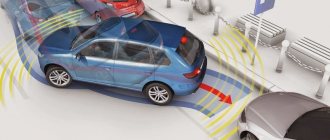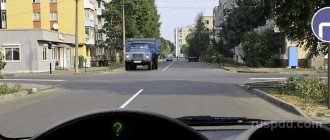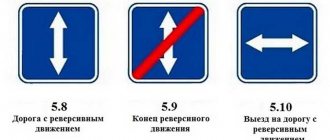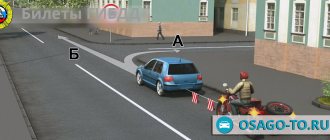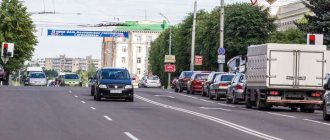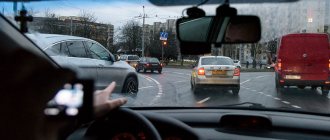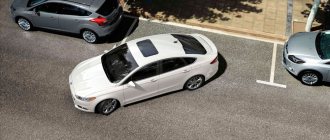Meaning of sign and variety
The sign has a digital designation of 5.5 in the traffic rules. This means the following - the road or roadway, which is located immediately behind this sign, has one-way (hereinafter also referred to as unidirectional) traffic. Simply put, there is no oncoming lane (it is located somewhere else).
Like almost all prescriptive signs, this one is designed as a square with a blue background, inside of which there is a white arrow pointing upward (see picture).
There are also subspecies 5.5:
- 5.7.1 – means that the road located to the right of the motorist has unidirectional traffic;
- 5.7.2 - means that on the road located to the left of the motorist, traffic is carried out exclusively in one direction.
These signs differ only in the direction of the white arrows. The shape of these signs is rectangular, the background is blue.
There is also an end of road sign (5.6), indicating the end of a section of road with traffic in one direction only. Immediately after this sign, two-way traffic begins - the left side of the road automatically becomes the oncoming side (unless otherwise regulated by sign 5.15.7 or road markings).
Expert opinion
Artemyev Dmitry
Experience as a forensic expert in the field of automotive technical examination for more than 2 years, more than 3 years of work in the field of insurance disputes, appealing guilt in road accidents.
Ask a Question
Did you know? Additionally, the start of two-way traffic may be indicated by warning sign 1.21.
5.6 looks like 5.5 - the only difference is that the first one has a diagonal red line (see photo).
There is also a 3.1 index (the so-called “Brick”). It is installed on the opposite side of a unidirectional road. Simply put, if the driver passes under the “brick”, then the traffic flow will meet him halfway. Route vehicles can enter under the “brick”, but an additional sign must be installed for them - 5.11.1.
Penalty for driving against one-way traffic – expert’s answer:
Arrangement rules
The placement of signs is carried out in accordance with GOST 52289-2004.
Some excerpts from there:
- 5.5 may not be installed to mark one-way roads leading to road service facilities (for example, gas stations), as well as on roads with separate routes;
- signs 5.7.1, 5.7.2 may not be installed near exits from courtyards and other adjacent territories, when entry there is possible only from roads indicated by sign 5.5;
- warning sign 1.21, signaling the start of two-way traffic, is installed outside cities at a distance of 150 - 300 meters, inside populated areas - 50 - 100 meters;
- 3.1 is installed immediately before the entry ban begins (including near gas stations, where 5.5 is not specifically installed);
- some signs can be re-installed - 5.5 or 5.11.1 - for example, after intersections with a complex layout.
Fine for driving on one-way traffic
The main sanction provided for driving in oncoming traffic is the imposition of an administrative fine in the amount of 5,000 rubles.
If the driver proceeded to the one-way lane legally, but did not stick to the left edge or did not turn on the hazard lights, then he will be fined 500 rubles.
The penalty for driving on a one-way road is not limited to just a fine. If the driver was drunk, did not respond to comments or created an emergency situation, then as a sanction the traffic police officer may choose to deprive the driver of the right to drive a vehicle for a period of 4 to 6 months.
Is it possible to appeal a fine or evade it?
A citizen can evade paying a fine only in three cases:
- There was an emergency situation, and driving into oncoming traffic was necessary in order to avoid an accident;
- I had to drive into the oncoming lane due to a car malfunction;
- The one-way traffic sign was not visible due to trees, weather (covered with snow), or it was completely absent.
In all other situations, driving onto a one-way road is impossible, regardless of the reason. Even if you took a sick relative to the hospital, traffic police officers will still have to impose an administrative penalty on you.
A fine for driving on one-way traffic can be appealed in court, but in such cases it is extremely difficult to prove your innocence. If the driver does not have strong evidence that can confirm one of the above facts, then it is better not to start the case.
If a citizen can confirm his innocence with facts (records from a car registry, acts of the insurance service), then in order to protect his rights, he needs to file a claim with the administrative court at his place of residence.
Such cases are considered within 60 days. The defendant in the case should not be a specific traffic police inspector, but the entire organization as a whole.
Travel options
When driving onto a one-way road, a citizen must consider the following:
- a one-way road can have several lanes (like a two-way road) - then you can take any convenient lane (if the one-way road is located in a populated area);
- when a one-way lane has three or more lanes, the leftmost lane can only be occupied during very heavy traffic, or when all other lanes are occupied, or for the purpose of changing lanes, or turning left, making a U-turn (in the latter case, if there is further two-way road);
- driving onto sidewalks and roadsides is prohibited;
- Before starting any maneuver, do not forget to signal with turn signals;
- a one-way road may have a dedicated bus lane (indicated by signs 5.11.1, 5.13.1, 5.13.2) - entering this “dedicated lane” is prohibited.
One-way traffic rules
Traffic regulations include driving onto a one-way road as one of the most serious violations. The fine for this type of offense varies depending on the surrounding circumstances, but it is almost impossible to avoid it.
One way traffic sign
Driving into oncoming traffic or into a lane in which people are moving in one direction is not always due to the driver’s malicious intent. Sometimes a short-term traffic violation is possible if it does not create an emergency situation or interfere with the movement of other vehicles.
First of all, the law provides for the opportunity to take a one-way road if this is necessary in order to avoid an accident. In this case, the subject cannot be fined due to the urgency of the situation, but the need for such a maneuver will still need to be proven to the road service. Recordings from a DVR are best suited for this.
It is also legal to go onto a one-way road to perform a maneuver. In this case, the subject must reverse (during a maneuver) or otherwise move the car on the left side of the track and without turning off the emergency lights, which should warn other road users about a critical situation.
In addition, the law allows reversing on a one-way road for cars that enter such a road from a yard or from another street, and they need this in order to change lanes and continue moving. Such a ride cannot last long.
The beginning and end of a one-way road are marked with corresponding road signs - white arrows (one and two, respectively) on a blue background. Even if the road markings imply two-way traffic, it is the signs that have legal force. Sometimes the beginning of the path with moving in one direction is about (a red circle with a white stripe in the middle).
Departure methods
When the motorist saw sign 5.6, then after 150–300 meters outside the city (50–100 meters inside the settlement) the one-way road will end, so you need to prepare to leave it.
Important! 5.6 may not be installed if the total length of a one-way road is less than 100 meters, or if there is a T-shaped intersection at the end of its operation, or with a roundabout.
The departure rules are simple:
- when you need to continue driving in a forward direction, you should drive in the same lane as you were driving on a one-way road - the main thing is not to end up in oncoming traffic;
- if necessary, go to the right, you should give the appropriate turn signal, take the far right lane (paragraph 2 of clause 8.6 of the traffic rules), let pedestrians cross the roadway pass, and finally turn so that you are also in the far right lane;
- if you need to go left, you should take the far left lane (taking into account that the road will become two-way only after the intersection, either immediately after installing 5.6, or 150–300 (50–100 meters) after 1.21), turn on the left turn signal, let cars pass , moving straight or to the right, and, finally, turn so as not to end up in oncoming traffic (immediately after the left turn, you can enter any passing lane - not necessarily the far right one).
Reversing on a one-way road
Reversing through a one-way traffic zone is not one of the expressly prohibited maneuvers. But such movement must be associated with an objective necessity - parking, avoiding obstacles, etc. If the driver missed a necessary turn, he will have to drive an extra block to return, making a small detour.
This maneuver is permitted provided that no obstacles are created to other road users. It is also necessary to take into account the presence of additional prohibitions, which are indicated by the corresponding signs.
Stopping and parking
Stopping and parking of vehicles on roads intended for one-way driving only is carried out in accordance with the general rules specified in Section 12 of the Traffic Rules:
- The vehicle must be parked on the side of the road, and when there is no shoulder, it is allowed to be parked along the edge of the roadway;
- stopping and parking for passenger cars less than 3500 kg are allowed both on the right and on the left (only in populated areas);
- trucks weighing more than 3500 kg may stop on the left solely for the purpose of loading and unloading;
- when there is less than 3 meters between the stopped vehicle and the opposite edge of the roadway, stopping or parking is prohibited;
- you also cannot stop or stand closer than 15 meters from the stopping places of route vehicles and closer than 5 meters in front of pedestrian crossings;
- In addition, these actions are prohibited when the corresponding signs are 3.27, 3.28, 3.29, 3.30.

